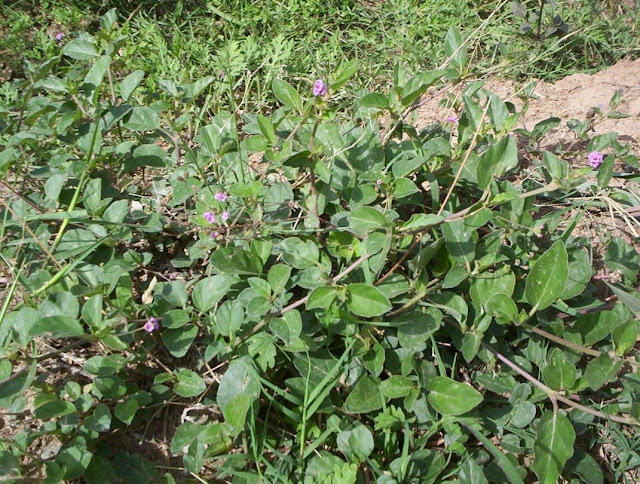Plants have been used to cure various health problems worldwide since time immemorial. The ethnic communities are the repositories of information on the therapeutic applications of plants and their products. Punarnava, botanically known as Boerhavia diffusa (Family: Nyctaginaceae), is one of the most important medicinal plants in India. It finds extensive use in Ayurveda, Unani, Sowa Rigpa and Folk medicine. It is widely distributed in the countries of the Southern hemisphere. In India, it occurs throughout the country except for high-altitude ranges in the Himalayas.
|
NAMES
IN DIFFERENT LANGUAGES |
|
English:
Red hogweed, Wineflower, Tar Vine, Spreading hogweed, Red spiderling, Horse
purslane, Pigweed Hindi:
Punarnava, Satha, Biskhapara, Shothagni
Sanskrit: Punarnava, Shothagni, Varshabhu Assamese:
Pananua Bengali:
Punarnova, Gadapushpa Gujarati:
Satodi, Vasedo Kannada:
Adakaputta, Adakaputtana gida, Komme, Gonajaali, Sanaadikaa, Balavadike,
Belavadaka, Shavaata, Shivaata, Shivaatike, Nadumurukana balli Malayalam:
Talutama, Tavilama Marathi:
Khapara, Khapari, Ghetoli, Ghetula, Punarnava, Vasu Pahari:
Itsit, Utchhat Punjabi:
Itsit Tamil:
Mukkurttaikkoti, Sukuaetti Telugu:
Atakamamidi Urdu:
Tukhm-i-ispast |
MORPHOLOGY
Punarnava
is a perennial, much-branched, creeping herb with fusiform roots. Stem is purplish
and somewhat thickened at nodes. Leaves are opposite, ovate, suborbicular or
rounded with entire and wavy margins. They are slightly pinkish in colour.
Flowers are arranged in small umbels forming corymbose, axillary and terminal
panicles.
More
than 64 phytochemicals have been isolated from Punarnava. Some of the major phytoconstituents
present in Punarnava are Phenolic glycoside (Punarnavoside), C-Methyl flavone (Borhaavone),
Isoflavone (2′-O-Methyl abronisoflavone), Flavonol (Quercetin, kaempferol), Flavonoid glycoside, Phenolic acid (trans-caftaric acid), Rotenoids
(Boeravinones A-S), Xanthone (Boerhavine), Lignans,
Purine nucleoside (Hypoxanthine-9-L-arabinofuranoside), Sterol (Boerhavisterol),
Sterol ester (Boeravilanostenyl
benzoate) and Ecdysteroid (β-Ecdysone).
MEDICINAL USES
Punarnava
is used for curing
many diseases in Indian and other systems of
medicine. Some of the important medicinal uses are discussed below:
Punarnava
has multiple health benefits for human beings. Its Ayurvedic name, Punarnava
(punar- again + nava- new) itself translates into “rejuvenator or the one that
renews the body”. It is useful for the liver, kidney and heart, the most important
trio in our body.
Punarnava
is considered useful in curing many problems of the urinary system, including
dysuria, urinary obstruction, calculi and urinary tract infection (UTI).
Punarnava is used widely for curing jaundice and other liver ailments in many traditional systems of medicine. Recent experimental studies have also proved Punarnava effective in restoring the normal liver function enzyme markers in the blood serum.
Experimental
studies have shown that alkaloid Punarnavine present in Punarnava can suppress metastasis in inoculated tumours
in lab animals.
Leaf
decoction of Punarnava is used in folk medicine for its analgesic and
anti-inflammatory properties. Its vernacular name, sothaghni, itself correlates
to that which alleviates inflammation. The anti-inflammatory activity of
Punarnava can be attributed to the presence of liriodendrin, quercetin, and
kaempferol present in this plant.
Punarnava
contains many phytochemicals, including rotenoids. Rotenoid derivatives have spasmolytic
activity, which has been experimentally proved by many researchers.
Leaves
of Punarnava are used for the treatment of asthma in some countries.
Roots
of Punarnava are used for the treatment of epilepsy and seizures in folk medicine,
which has also been proven experimentally.
Antibacterial
activity of Punarnava root extract has been reported by many researchers
against Streptococcus group, E. coli, Bacillus
subtilis , Neisseria gonorrhoeae, Salmonella typhimurium, Shigella
dysenteriae, Corynebacterium diphtheriae and Clostridium
tetani.
Roots
of Punarnava possess a potent antifungal activity against Microsporum gypseum, M. fulvum and M.
canis.
Many
phytochemicals show antioxidant and free radical scavenging activity.
Experimental studies have proved that Punarnava plants possess considerable antioxidant,
anti-inflammatory and free radical scavenging activity.
Punarnava is an integral part of many Ayurvedic and Siddha preparations such as Punarnavarishta, Punarnava guggulu, Punarnavasava, Punarnavadi kvatha churna, Punarnavastaka kvatha, Sukumara ghrita, Maha Narayan taila, Sothaghna lepa, Varuni, Talakacenturam, etc.
Punarnava
is a widely used for centuries in Ayurveda. Some toxicity studies, such
as those by Orisakwe
et al. (2003), have reported acute and sub-chronic
toxicity of punarnava leaves at 500, 1,000, and 2,000 mg/kg of body weight in
albino mice and rats. They reported the lethal dose (LD50) at more
than 2,000 mg/kg of body weight.
.JPG)
.JPG)

.JPG)
.JPG)
.JPG)


.JPG)